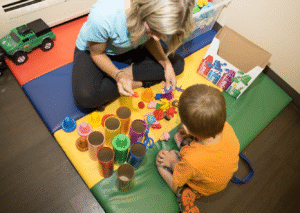Reflex integration and sensory processing work together to support the development of the nervous system. This helps movements and learning become automatic, which is important for developing functional skills and behavior regulation, including managing stress.
Treatments for all the foundational stages of brain development can be enhanced using reflex integration techniques and exercises. Let’s dive into reflex integration and how it works.
What Are Reflexes?
A reflex is an automatic, repetitive movement that starts before birth and is essential for developing normal movement patterns. Reflexes help build pathways between the brain and body, allowing us to respond to stimuli without thinking. In infants, reflexes are critical for protection and survival. As we grow, they become building blocks for physical, emotional, and cognitive development.
The Role of Reflex Integration
As reflexes mature, they become integrated, allowing for more complex skills like vision, hearing, balance, mobility, communication, and abstract thinking. However, if a reflex doesn’t mature, it can remain unintegrated, disrupting the brain’s pathways. This can affect many areas of development, including physical coordination, emotional regulation, and cognitive skills.
Sometimes reflexes don’t mature or emerge as they should, leading to dysfunction. Unintegrated reflexes can be caused by factors like:
- Limited movement during infancy or early childhood
- Congenital disorders or anomalies
- Birth trauma or physical trauma
- Emotional trauma or chronic stress
- Environmental toxins

When reflexes remain unintegrated, they can cause unintended, involuntary movements, creating confusion within the nervous system. This confusion can lead to problems with coordination, reading, writing, speech, and emotional regulation.
Physical and occupational therapists use reflex integration techniques to help build a stable neurological foundation. This promotes better control over body movements and improves sensory regulation, which supports emotional balance and behavior. A well-regulated sensorimotor system is key to learning and overall development.
The Moro Reflex: An Example of Reflex Integration
The Moro reflex is active from birth until around 3-4 months of age. It’s triggered by a sudden change in the infant’s head or body position, causing a characteristic “startle” response. This reflex is crucial for helping the infant develop self-organization, inner control, and stress management.
When the Moro reflex integrates, it helps with balance, coordination, behavior regulation, and creativity. However, if it remains active beyond the normal timeframe, it can lead to emotional instability, stress, and difficulty with other reflexes.
Why Reflex Integration Matters for Your Child

If your child struggles with emotional regulation, stress management, or coordination, reflex integration therapy could help. A multidisciplinary approach involving physical, occupational, and speech therapy can improve how your child responds to sensory stimuli and their environment.
If you think your child may show signs of reflex issues, talk to your pediatrician. They can refer your child for an occupational therapy evaluation. If the evaluation shows signs of sensory and motor dysregulation, there are many treatment options to help your child succeed at home and school.
Take the first step today by scheduling an evaluation with our team at Crawl Walk Jump Run. With personalized care and the right support, your child can thrive both at home and in school, gaining the tools they need for a brighter, more successful future. Let us help guide your child’s development every step of the way.




